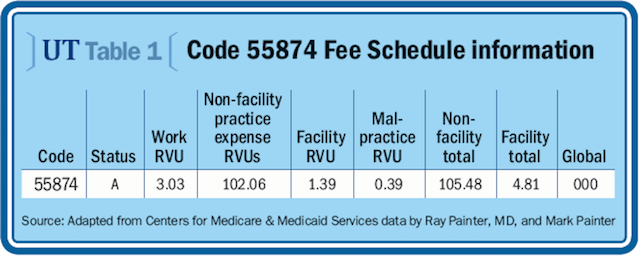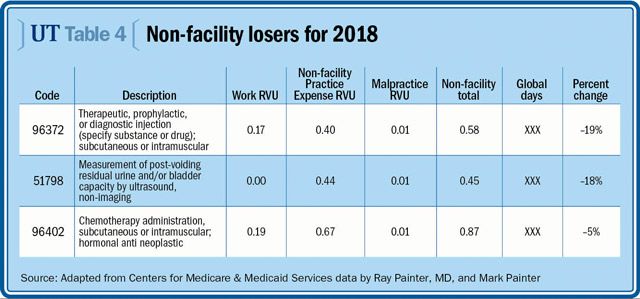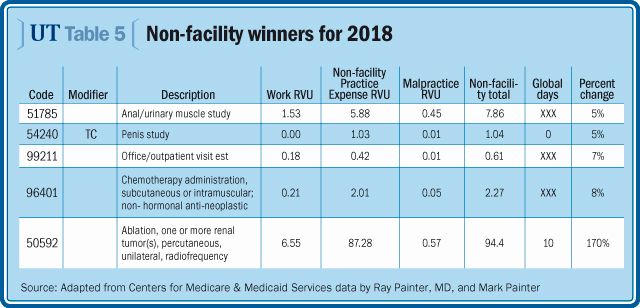Article
Medicare final rule: Urologists’ pay set to decrease (again)
In this article, we provide a summary of CPT changes for 2018, the Medicare Physician Fee Schedule final rule, and the final rule for the Quality Payment Program.


It’s that time of year of again. As we wrap up 2017, it is time to prepare for next year. Urology was spared any significant changes in ICD-10 when that system was updated officially Oct. 1, 2017. In this article, we provide a summary of CPT changes for 2018, the Medicare Physician Fee Schedule final rule, and the final rule for the Quality Payment Program.
New CPT codes
Effective Jan. 1, 2018, the American Medical Association-developed CPT coding system will contain one new code in the Genitourinary System. Two new codes related to Oncology testing for prostate cancer were added to the Molecular Pathology tier 2 codes (81541 and 81551) and two new Proprietary Laboratory Analyses (0005U and 0023U) were added. (We will save discussion on coverage and use of these codes for a subsequent article.)
Also by the Painters: How to get reimbursed for BPH water vapor ablation
Code 55874 (Transperineal placement of biodegradable material, peri-prostatic, single or multiple injection[s], including image guidance, when performed) replaces CPT category III code 0438T and will be available Jan. 1, 2018 to report the insertion of SpaceOAR Hydrogel. Medicare has assigned the code a status of A (active) and relative value units (RVUs) for both the facility and non-facility setting as noted in table 1.

The final rule for the 2018 Hospital Outpatient Prospective Payment System (HOPPS) has also established a payment pathway for the code, allowing possible payment in the facility in outpatient and ambulatory surgical center settings.
Medicare Administrative Carriers (MACs) are allowed to develop specific coverage instructions in the form of either a local coverage article or a local coverage determination, but generally inclusion in both the Medicare Physician Fee Schedule and the HOPPS means that Medicare will cover the service if it is medically necessary. We encourage you to continue to monitor bulletins and MAC websites for any further reporting or coverage instructions. Private payer payment, as we all know, is not required to comply with Medicare decisions and must be determined on a payer-by-payer basis based on patientplan.
Finally, a few CPT-related changes to standard x-rays for the abdomen and chest will also become effective Jan. 1, 2018. If you are providing these services, please review the CPT book. AUAcodingtoday.com will add new CPT codes to the database on Jan. 1, 2018. A list of all 162 additions to the system is available for subscribers as a download sheet on the landing page.
Next: Physician Fee Schedule final rule
Physician Fee Schedule final rule
We have highlighted a few issues below that we feel are important for urology practices to consider.
Read - Financial planning: Your year-end ‘to do’ list
Telemedicine. The Centers for Medicare & Medicaid Services continues to increase the number of services payable when furnished via telehealth, adding seven codes to the covered list for a new total of 94. A list of covered services for Medicare can be found at: bit.ly/Telemedicineservices.

Recall that for all but Alaska and Hawaii, to be covered by Medicare, telemedicine services require the patient to be in a qualified facility, and synchronous audio and visual services must be employed. There is no change to this requirement for 2018. However, reporting of telemedicine services in 2018 will no longer require remote providers to use modifier –GT, only that the Place of Service code of 02 be placed appropriately for the service provided.
Radiology. Beginning in 2018, claims for x-rays taken using computed radiography/cassette-based imaging must include modifier “FY,” which will result in the applicable payment reduction. The modifier will result in the 7% applicable payment reduction of –TC through 2022 and a reduction of 10% for claims beginning in 2023.
All services using computed radiography/cassette-based imaging must include modifier “FY,” including those services reported as global (both TC and –26) provided by the same provider on the same date.

Payments. The conversion factor for 2018 will be $35.9996, up slightly from $35.8887 this year. CMS each year calculates the impact of the combined changes to the work, malpractice, and practice expense RVUs using volume of services from a previous full year for the specialty (2016 for this year) and the final conversion factor to project the overall impact of the changes on each specialty. Urology, for the second year in a row, is projected to be down. This year, the changes are projected to result in a 1% overall decrease in payments to urologists.
The vast majority of RVUs did not change for codes typically reported by urology practices. Tables 2-5 contain changes in codes that resulted in a change in RVU total value of 5% or greater without taking into account Geographic Cost Adjustment. Note that tables 2 and 3 indicate changes in RVUs for payment in a facility setting and do not reflect the percentage change that would occur in a non-facility setting (physician’s office). Tables 4 and 5 reflect changes only for the non-facility setting.
Also see: If disaster strikes, is your practice prepared?
Note that the value for transurethral resection of the prostate (TURP), CPT code 52601, is included in the “facility loser” table. TURP was targeted by CMS as a potentially misvalued code and was required to be evaluated by the RVS Update Committee. The primary concern noted by CMS was the change in the majority of TURPs to a service provided in an outpatient surgical session. In short, the technique changes and pressures of the system have resulted in a majority of patients receiving a TURP without being admitted to the hospital.
Next: PQRS, meaningful use, the VBM
Physician Quality Reimbursement System, meaningful use, and the value-based modifier (VBM). Although PQRS, meaningful use, and the VBM are no longer standalone requirements or measurements, as we are not reporting under MACRA requirements for 2017, CMS has reached back to provide some relief to physicians for their reporting or lack thereof in 2016.
Read: How to choose between Roth, traditional accounts
First, both meaningful use and PQRS requirements were scaled back from those outlined during the 2016 reporting period to requirements that are congruous with MACRA/Merit-based Incentive Payment System (MIPS) requirements. By changing these requirements, those who may have initially “failed” one or both programs may potentially be considered as having “passed.”

Second, CMS has cut payment reductions in half for the VBM. For small practices, this means the penalty, if applicable, will be –1% for groups under 10 and –2% for groups greater that 10.
Finally, CMS has indicated that any group having met the PQRS criteria would not be subject to a downward VBM adjustment.
Much of the proposed rule for the 2018 reporting period for CMS Quality Payment Program, covered in a previous article (“Proposed MIPS rule modifies 2018 requirements"), was accepted as proposed. However, there were a few notable changes.

Essentially unchanged from the proposed rule:
- Pick your pace is no longer available.
- The threshold for inclusion has increased to $90,000 or 200 patients.
- The reporting period for Quality (replaces PQRS) is 12 months; Advancing Care Information (replaces meaningful use), 90 days; and Improvement Activities, 90 days.
- Quality measures: Limited changes were made to reporting methods and no change to recommended urology measures. (One small change: assigned a measure number [462] to an Oregon Urology Institute measure included in proposed rule.)
- Advancing Care Information: As proposed, 2014 CEHRT is allowed. 2015 CEHRT awarded bonus points counts of 25% of total score.
- Improvement Activities: This counts as 15% of score, with no changes to scoring methodology or reporting requirements for 2017.
- Virtual groups consisting of 10 or fewer providers per Tax ID Number will be allowed to assist with defraying cost of the program implementation.
- 70-point minimum MIPS score is required for potential bonus participation.
- Small practices of 15 providers or fewer will be awarded a bonus of five points for participation.
- Penalty and bonus rates remain 5% for failure (bonus based on penalties).
Changes:
- Cost factor will be included at 10% of score for the 2018 reporting period. Quality reporting will be decreased to 50% to accommodate this change.
Note: Cost reporting does not require any additional submissions or attestation. Cost is calculated by CMS using claims data.
Also see: Are you taking steps to prevent data breaches?
Alternative payment models (APMs) and accountable care organizations (ACOs) remain an option for MACRA participation for bonus payment. These programs are available to groups moving toward alternative payment methods under the Medicare program.
Next: Conclusion
Conclusion
The AUA has additional summaries for both the Medicare Physician Fee Schedule final rule and the Quality Payment Program final rule for 2018. Depending upon your size and your service mix, the impact of 2018 changes may be larger or smaller than the average. When building your business projections for 2018, you will also need to take into account the 2017 value changes to cystoscopy and other procedures for private payers moving fee schedules or RVUs from previous Medicare data sets to 2017 or 2018 data. Continue to work on MIPS and improve your documentation and coding for ICD-10 and CPT supporting medical necessity and meeting coding requirements.
You can survive this onslaught of change, but you may need help. Take a controlled and educated approach, take on what you can, look for help where you need it, and implement change in an organized and incremental fashion.
More from Urology Times:
[Video] Prescription for financial health: Tips for early-stage physicians
Practice ‘report card’ tracks performance
You can deliver chronic care services; here’s how
The information in this column is designed to be authoritative, and every effort has been made to ensure its accuracy at the time it was written. However, readers are encouraged to check with their individual carrier or private payers for updates and to confirm that this information conforms to their specific rules.
Subscribe to Urology Times to get monthly news from the leading news source for urologists.

















